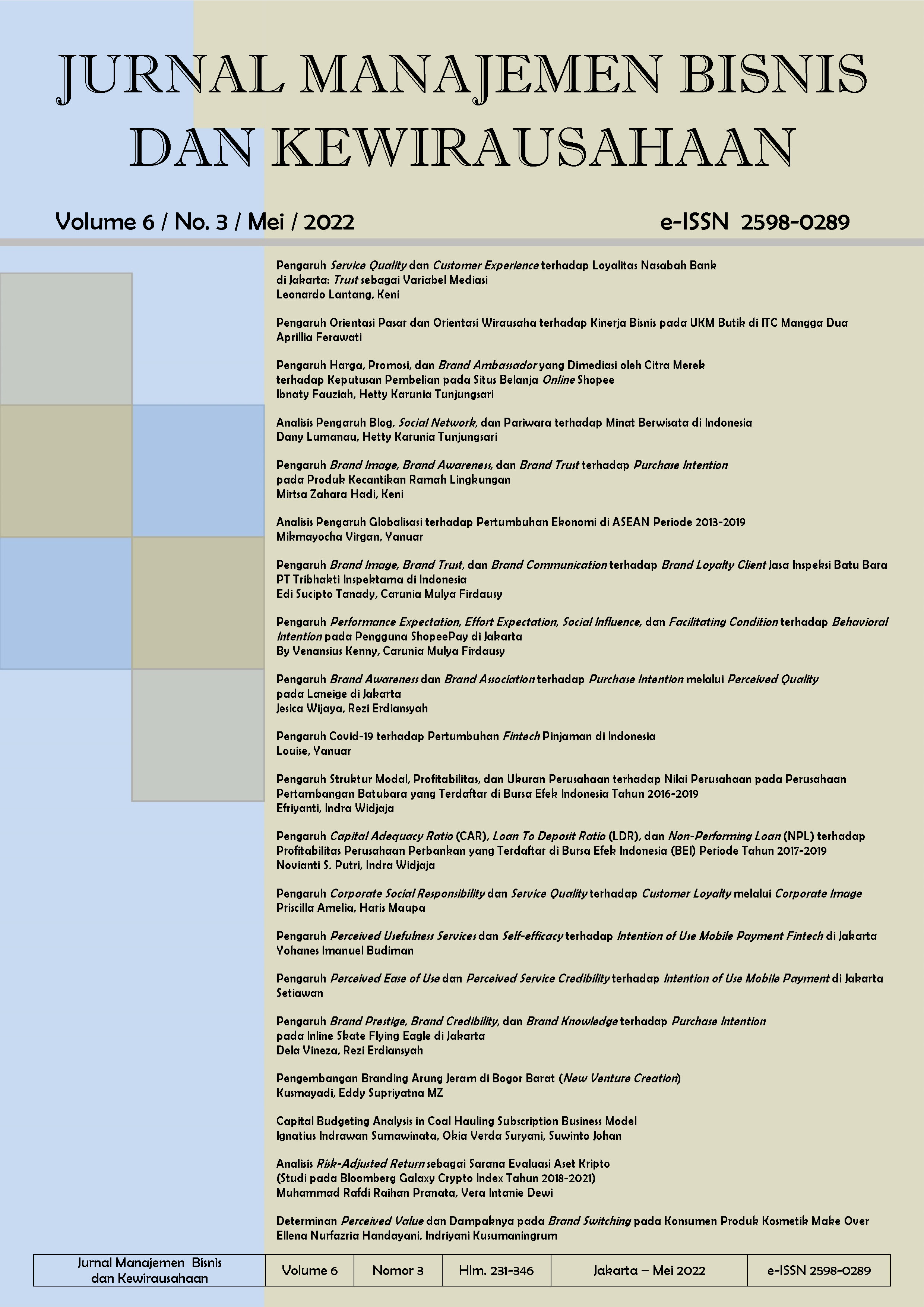Analisis Risk-Adjusted Return sebagai Sarana Evaluasi Aset Kripto (Studi pada Bloomberg Galaxy Crypto Index Tahun 2018-2021)
Main Article Content
Abstract
The purpose of this study is to measure the risk-adjusted return of cryptocurrencies that are included in the Bloomberg Galaxy Crypto Index and to identify whether there are any significant differences in the results of the three performance assessment methods used. The research period is from January 2018 to October 2021. The analysis was done using Sharpe Ratio, Treynor Ratio, Jensen’s Alpha, and Kruskal-Wallis test by Rank (One-way ANOVA on Ranks). The analysis results show that ETC and ETH are the best performing assets compared to 8 other crypto assets where ETC has the best performance for 2021 based on the Sharpe and Treynor ratio, while ETH in the last two years has the best value in 2020 and the second-best in 2021 based on Sharpe ratio. The test result shows that p = 0.095, which indicates that the significance value is >0.05, meaning that there is no statistically significant difference between the assessment results of the three methods used.
Tujuan dari penelitian ini adalah untuk menilai risk-adjusted return dari aset kripto yang terdaftar pada indeks Bloomberg Galaxy Crypto serta mengidentifikasi ada atau tidaknya perbedaan yang signifikan atas hasil dari ketiga metode penilaian kinerja yang digunakan. Periode penelitian yang dilakukan yakni dari Januari 2018 hingga Oktober 2021. Analisis dilakukan dengan menggunakan Sharpe Ratio, Treynor Ratio, Jensen’s Alpha, dan uji beda Kruskal-Wallis (One-way ANOVA on Ranks). Hasil analisis menunjukkan ETC dan ETH merupakan aset dengan kinerja terbaik dibandingkan dengan 8 aset kripto lainnya, dimana ETC memiliki kinerja terbaik untuk tahun 2021 berdasarkan penilaian rasio Sharpe dan Treynor, sedangkan ETH pada dua tahun terakhir memiliki nilai terbaik pada tahun 2020 dan kedua terbaik pada tahun 2021 berdasarkan rasio Sharpe. Dari hasil uji beda didapatkan p = 0.095 yang menunjukkan bahwa nilai signifikansi >0.05, maka diketahui bahwa tidak ada perbedaan signifikan secara statistik antara hasil penilaian dari ketiga metode yang digunakan.
Article Details
Section
This work is licensed under a Jurnal Manajemen Bisnis dan Kewirausahaan Creative Commons Attribution-ShareAlike 4.0 International License.
Notice: Deprecated: The template at plugins/themes/bootstrap3/templates/plugins/generic/citationStyleLanguage/citationblock.tpl has moved and will not be found in the future. in /var/www/html/lib/pkp/classes/plugins/Plugin.php on line 468
How to Cite
References
Anggara, A. W., & Yulianto, A. (2017). Analisis kinerja reksadana saham dengan metode Sharpe, Treynor dan Jensen. Management Analysis Journal, 6(1), 13–22. https://doi.org/10.15294/maj.v6i1.10270
Arifudin, O., Wahrudin, U., & Rusmana, F. D. (2020). Manajemen risiko. Widina Bhakti Persada Bandung.
Bianchi, D. (2020). Cryptocurrencies as an asset class? An empirical assessment. Journal of Alternative Investments, 23(2), 162–179. https://doi.org/10.3905/JAI.2020.1.105
Claransia, S. O., & Sugiharto, T. (2021). Performance analysis of stock portfolios incorporated in IDX30 using the Sharpe, Treynor and Jensen method in 2016-2020. Enrichment: Journal of Management, 12(1), 236–242. https://enrichment.iocspublisher.org/index.php/enrichment/article/view/198/146
Frisby, D. (2014). Bitcoin: The future of money? (1st ed.). Unbound.
Greer, R. J. (1997). What is an asset class, anyway? The Journal of Portfolio Management, 23(2), 86–91. https://doi.org/10.3905/jpm.23.2.86
Hartono, J. (2017). Teori portofolio dan analisis investasi (11th ed.). BPFE.
Hashemi Joo, M., Nishikawa, Y., & Dandapani, K. (2020). Cryptocurrency, a successful application of blockchain technology. Managerial Finance, 46(6), 715–733. https://doi.org/10.1108/MF-09-2018-0451
Hertina, D., Destriani, N., Naufal, M. D., Dauliah, R. D., Sinaga, D. S., Nursapriti, A. W., & Saudi, M. H. (2021). Sharpe, Treynor and Jensen methods in doing stock portfolio performance analysis. Review of International Geographical Education Online, 11(5), 829–834. https://doi.org/10.48047/rigeo.11.05.78
Kartozhnykov, K. (2021). International investment portfolio diversification using cryptocurrencies [Master Thesis, Radboud University]. https://theses.ubn.ru.nl/bitstream/handle/123456789/11476/Kartozhnykov%2C_Kyrylo_1.pdf?sequence=1
Liu, W. (2019). Portfolio diversification across cryptocurrencies. Finance Research Letters, 29, 200–205. https://doi.org/10.1016/j.frl.2018.07.010
Ma, Y., Ahmad, F., Liu, M., & Wang, Z. (2020). Portfolio optimization in the era of digital financialization using cryptocurrencies. Technological Forecasting and Social Change, 161, 120265. https://doi.org/10.1016/j.techfore.2020.120265
Mahessara, R. D., & Kartawinata, B. R. (2018). Comparative analysis of cryptocurrency in forms of bitcoin, stock, and gold as alternative investment portfolio in 2014-2017. Journal of Secretary and Business Administration, 2(2), 38. https://doi.org/10.31104/jsab.v2i2.58
Saputra, H. I., & Anastasia, N. (2013). Jenis investasi berdasarkan profil risiko. Finesta, 1(2), 47–52. https://publication.petra.ac.id/index.php/manajemen-keuangan/article/view/1172
Smart, S. B., Gitman, L. J., & Joehnk, M. D. (2017). Fundamentals of investing (13th ed.). Pearson Education.
Soehartono, & Pati, U. K. (2019). The Regulation of Cryptocurrency Investation in Indonesia. Proceedings of the 3rd International Conference on Globalization of Law and Local Wisdom (ICGLOW 2019), 358(September 2017), 209–212. https://doi.org/10.2991/icglow-19.2019.54
Tuerah, C. (2013). Perbandingan kinerja saham LQ 45 tahun 2012 menggunakan metode Jensen, Sharpe dan Treynor. Jurnal EMBA: Jurnal Riset Ekonomi, Manajemen, Bisnis dan Akuntansi, 1(4), 1444–1457. https://doi.org/10.35794/emba.v1i4.2925
Vigna, P., & Casey, M. (2016). The age of cryptocurrency: How bitcoin and the blockchain are challenging the global economic order. Picador.


